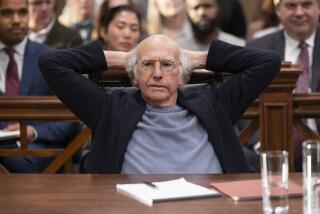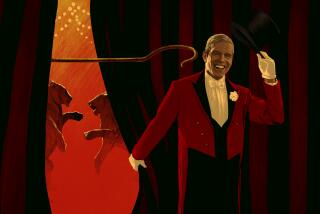From the Archives: The pricey ‘Full House’ has fallen out of step as programmers look for hip, young viewers
As the Tanners return in Netflix’s new “Fuller House,” we look back at the last days of ABC’s original “Full House.” This article originally ran in The Times on May 23, 1995.
Although the cast and producers of “Full House” were surprised when ABC canceled the popular sitcom three months ago after eight solid seasons, they were not surprised when nobody paid much attention.
See more of Entertainment’s top stories on Facebook >>
After all, they know that the true fans of “Full House,” which ends tonight in a one-hour episode, were never crotchety TV critics or industry cynics. Nor were they particularly ABC executives, who folded their dependable “Full House” to play a wild card come fall — “Roseanne” — in hopes of attracting more of the coveted 18-to-49 crowd on Tuesdays at 8 p.m.
Who are the real “Full House” fans? Bob Saget has seen them with their faces pressed to the glass in the next car over.
“It’s a very loving show,” said the former stand-up comedian and the father of three girls, both on the show and in real life. “When a car drives by and the kid in the back seat waves and goes crazy, I can’t be cynical about that. You have a child who appreciates what you do.”
Candace Cameron has seen the real fans — anywhere from 5,000 to 20,000 of them at a time--during her 15 to 20 mall appearances across the country each year.
“‘Full House’ meant a lot to families who grew up with the show,” said Cameron, 19, who was only 10 when cast as oldest daughter D.J. Tanner. “So many of them are so disappointed that it won’t be on anymore. Parents just love their kids to watch, and they sit down to watch with them.”
John Stamos has seen the real fans, who made him a teen-magazine heartthrob.
“I went through phases with the show,” Stamos said. “In the beginning, I loved it and I was fired up and I wanted to do good stories. Then I got bored and I wanted to leave. Then I realized how important the show was to families and children, and I didn’t want it to end.”
In “Full House,” Saget portrayed a widowed talk-show host whose brother, a rock musician played by Stamos, and best friend, a comic played by David Coulier, help him raise his three young girls in a sitcom that could have been called “My Three Dads.”
For years, “Full House” was ABC’s star player, routinely ranking among television’s top 20 prime-time shows and helping the network build its successful “TGIF” lineup of Friday funnies. ABC used “Full House” to launch numerous hits, including “Home Improvement,” “Family Matters” and “Hangin’ With Mr. Cooper.”
But that was then. Despite ratings good enough to rank it 25th out of 142 prime-time network programs this season, “Full House” has fallen out of step. The old 8 p.m. “family hour” has slowly given way to programming for hip young adults, whom advertisers pay big bucks to reach.
Meanwhile, “Full House” had become one of the industry’s most expensive sitcoms to produce after so many years on the air, due to escalating producer fees and cast salaries. The $1.3-million budget per episode was easily double the average cost of most sitcoms.
“What we initially heard was that ABC felt the show was too expensive,” Coulier said. “Then we heard that the producers had offered to lower the license fee substantially, but ABC still wasn’t interested. At that point we felt, OK, if it’s no longer an economic issue, what really is the issue?”
Brian McAndrews, vice president of current series programs for ABC Entertainment, responded: “A lot of it was financial. We liked the show, the actors and the creative team working behind the scenes. But when a show of that age becomes more and more expensive every year, it comes down to the cost versus what it’s delivering. At some point, the cost becomes prohibitive.”
What “Full House” delivered was truckloads of kids, routinely ranking as the top-rated prime-time program among children 2 to 11. Ultimately, ABC felt that “Roseanne” was a better 8 p.m. candidate because its cutting humor attracts adults as well as children--even though it has always been considered too racy for young children.
“The business is just changing. They’re not making shows for kids and families anymore,” sighed executive producer Marc Warren, one of several producers and cast members who agreed to take a cut in pay, but to no avail. “The networks want to own a piece of their shows. All those factors came together and ABC made the decision — unfortunately too late to give the show a send-off that fans would enjoy.”
The cast was rehearsing for the season finale when news of the cancellation trickled down in February. They were frustrated that they were not properly notified of the show’s demise. Coulier said: “In the end, the whole thing left a little bit of a sour taste in everyone’s mouth.”
There was no time to write a series finale, so the show’s season finale had to do. But at the end of tonight’s episode, the producers added a curtain call, where the actors come out from behind the stage and take a bow. The actors knew this was their final curtain, and many of them had tears in their eyes.
In March, Warner Bros., the studio behind “Full House,” discussed moving the sitcom over to its new WB Network. But by that time, the cast was over it. When executive producer Bob Boyett polled the actors, they all balked.
“If Warner Bros. had gotten involved in negotiations early, or thrown their hat in, it might have been a possibility,” Coulier said. “It was too little too late. In our heads, we had already moved on and put the show to rest.”
When “Full House” premiered in 1987, it followed a proud Friday night tradition of such family shows as “The Adventures of Ozzie and Harriet,” “Partridge Family,” “The Brady Bunch” and “Diff’rent Strokes.”
“We look at ‘Full House’ as the family every kid wishes he could be in,” said executive producer Dennis Rinsler. “You have three dads — a rock star, a comic and a talk-show host — who never put the kids down and always solved their problems with love and understanding.”
“Full House” was one of the only shows on television where a baby grew up on the show, providing a seasonal family photo album. Michelle, played by twins Mary-Kate and Ashley Olsen, was introduced at 6 months old, and viewers witnessed her toilet training, her first bites with a spoon and her first time on a bike. The Olsen twins, now fabulously famous at 8 years old, have their own lucrative network series and recording deal.
The rest of the cast is also faring well. Saget continues to host “America’s Funniest Home Videos,” and he’s executive producing a TV movie loosely based on the the death of his sister last year. Coulier sold his Mr. Woodchuck puppet--seen on “Full House”--to Toys R Us, and he’s pitching an animated series based on the character.
Stamos wants to get a gig with a bar band in Australia and then gun for a feature-film career. Lori Loughlin, who played Stamos’ wife, has been cast opposite Tony Danza in ABC’s new fall sitcom “Hudson Street.” Cameron is shooting a USA Network movie, and the other girls are pursuing TV work.
Warren and Rinsler point out that “Full House” is not likely to depart any time soon, despite its cancellation. Reruns can be seen locally, weekday evenings, on KTLA-TV Channel 5.
“My guess is that the show will be watched more now that it’s gone than when it was on,” Rinsler said.
“It will be a perennial in syndication,” Warren added.
“It’s ‘The Brady Bunch’ of the ‘90s,” Rinsler said.
Indeed, how many adults really noticed when “The Brady Bunch” was canceled by ABC in 1974? Legions of loyal children did.
“I don’t think people will really get ‘Full House’ for another five or 10 years,” Stamos said. “They just won’t understand the impact. A generation of kids have been watching this show their whole life.”
More to Read
The complete guide to home viewing
Get Screen Gab for everything about the TV shows and streaming movies everyone’s talking about.
You may occasionally receive promotional content from the Los Angeles Times.






